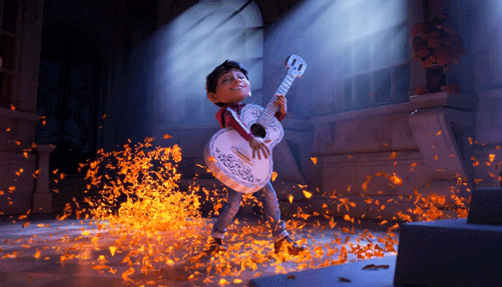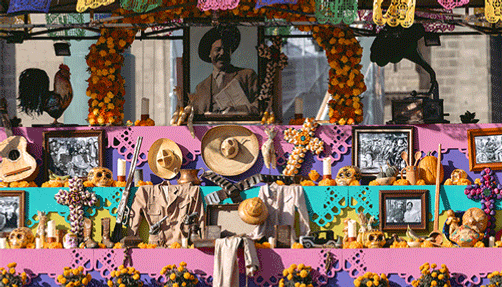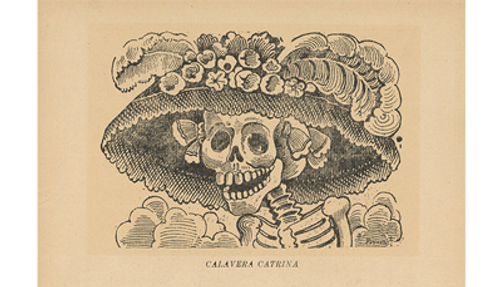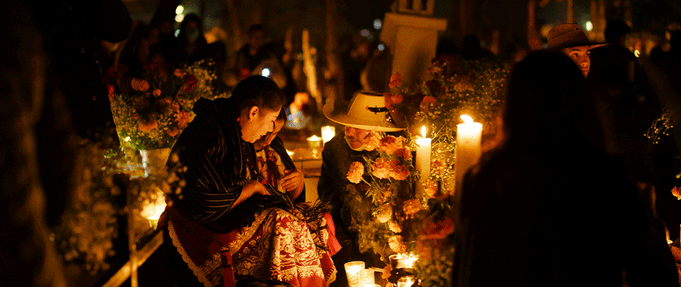In 2018, Coco became the biggest blockbuster in Mexican history and even won the Academy Award for Best Animated Feature that year. The story follows a young boy named Miguel, who is accidentally transported to the Land of the Dead on the Day of the Dead, when the barrier between the mortal and spiritual realms is dissolved.
Featuring an all-Latino voice cast, the film is a beautiful love letter to Mexican culture, folklore, and traditions. Many were swept away by the film’s vibrant colors and heartfelt songs. But what is not to be overlooked is Coco’s moving depiction of death, showing that it is not only inevitable but also natural.
That isn’t to say that losing someone isn’t painful, but, in Mexican culture, when there is the Day of the Dead to be looked forward to every year, in which the dearly departed return to earth, no one is ever truly gone.
Coco helped introduce many people who hadn’t heard of the special day to its message. And yet, there is still much more to discover about its origins and pastimes, while continuing to uphold what the Day of the Dead is all about: keeping families together.

The Origins of the Celebration
El Día de los Muertos, or the Day of the Dead, is a long-observed tradition that combines the Aztec custom of celebrating ancestors with All Souls’ Day, a holiday that was brought to Mexico in the early 1500s by Spanish invaders. A major celebration throughout primarily Mexico and Central America, it is a day to commemorate loved ones who have come and gone.
As noted, the earliest roots are with the Aztec people, who resided in what is now central Mexico. According to History, over a millennium before the Day of the Dead was consolidated, the Aztecs honored their dead with skulls. Today, skulls continue to play a key role in the holiday, as both a symbol of death and a way to remember the departed.
In the 16th century, when the Spanish conquered the Aztec empire, Indigenous celebrations were moved to coincide with the Catholic All Saints Day and All Souls Day, on November 1 and 2, respectively. The former honors the saints in heaven, while the latter, like Day of the Dead, is to pray for the souls who have left us.
As is tradition on Día de los Muertos, the gates of heaven are opened at midnight on October 31, and the spirits of children are welcomed to return for 24 hours, with food, drink, and overall cheer. The same applies on November 2nd, but the focus is shifted to remembering the spirits of adults.
Although celebrated on the same day, the tradition is not to be confused with Halloween. Despite the fact that, in recent years, particularly in the United States, the holidays are becoming increasingly drawn together, it’s important to continue to preserve the Mexican heritage and culture to be found in Día de los Muertos.
The Customs: Ofrendas, Skeletons, and Marigolds Abound!
Although there are many traditions observed during the Day of the Dead, the most vital is undoubtedly the ofrendas. While the border between the spirit and mortal world is dissolved, it is key that the living family members welcome the deceased back through an altar.
Usually built in homes or at gravesites, they consist of the loved one’s favorite foods, candles, marigolds—whose strong smell is said to help guide souls home—yellow cempasúchil flowers, pan de muerto—a special bread—and other items such as fruit, chocolate, candy, and toys. Often, the ofrenda revolves around life’s elements—water, wind, fire, and earth—and each will be represented in the objects chosen.
Families who build their altars at their loved one's grave often clean the tombstone during the day, and then on the night of November 2, take all their offerings to the cemetery.

An altar in Mexico City.
Photo Credit: Roger Ce / UnsplashMary J. Andrade, who was a Cultural Advisor for Coco, said that “When people are creating an altar, they are thinking about that person who is gone and thinking about their own mortality, to be strong, to accept it with dignity.”
A significant symbol of the Day of the Dead is calacas (skeletons) and calaveras (skulls). Several factors contributed to this taking root as a custom, notably, following the Spanish invasion, the mortality rates skyrocketed. In less than a century, the population of central Mexico decreased from over 25 million to just over 1 million.
Devastatingly, death became commonplace and was later represented in popular art, most notably in the work of printer and cartoonist José Guadalupe Posada during the 20th century. To satirize politicians and push forth revolutionary ideologies, he incorporated skeletons into his work.

La Calavera Catrina by José Guadalupe Posada (c. 1910).
Photo Credit: José Guadalupe Posada / Wikimedia CommonsWhat is considered Posada’s most famous depiction, la catrina, shows a female skeleton in makeup and fancy clothes, said to be a statement on Mexicans adopting European traditions over those of their own heritage.
In Mexico, some cities commemorate the holiday with parades and festivals, with many people painting their faces to look like skulls—or even dressing up as Posada’s la catrina.
Above all, as asserted by Michelle Téllez, an associate professor in the Department of Mexican American Studies at the University of Arizona, these customs exist because “if you remember them, they never cease to exist.”
Featured image: Caleb Hernandez Belmonte / Unsplash
